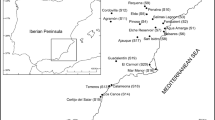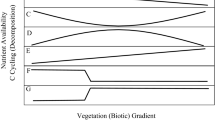Abstract
At Humingbird Cay, Exuma, Bahamas, distributions of bothRhizophora mangle (red mangrove) andAvicennia germinans (black mangrove) are closely correlated with amounts of hydrogen sulfide (H2S) in the soil.R. mangle is primarily distributed within large areas of low to moderate H2S concentrations (mean= 40 mg/l). H2S levels underA. germinans are lower (mean = 22 mg/l), but the area immediately beyond their root zone often has extremely high sulfide concentrations (mean= 120 mg/l). These results suggest that past attempts to explain mangrove distribution in terms of monotonic soil gradients, the dispersal characteristics of propagules, and interspecific competition are incomplete, and that it will be necessary to examine the link between soil sulfur chemistry and mangrove distribution more fully.
Similar content being viewed by others
References
Ball, M.C. 1980. Patterns of secondary succession in a mangrove forest of southern Florida. Oecologia 44: 226–235.
Carlson, P.R., L.A. Yarbro, C.F. Zimmerman, and J.R. Montgomery. 1983. Pore water chemistry of an overwash mangrove island. Florida Scientist 46 (314): 239–249.
Davis, J.H. 1940. The ecology and geologic role of mangroves in Florida. Publication 517 of Carnegie Institution, Washington D.C.
Dent, D. 1980. Acid sulfate soils: morphology and prediction. Journal of Soil Science 31: 87–99.
Egler, R.E. 1952. Southeast saline everglades vegetation, Florida, and its management. Vegetatio 3: 213–265.
Hesse, P.R. 1961a. The decomposition of organic matter in a mangrove swamp soil. Plant and Soil 14 (3): 249–263.
Hesse, P.R. 1961b. Some differences between the soils ofRhizophora andAvicennia mangrove swamps in Sierra Leone. Plant and Soil 14 (4): 335–346.
Howarch, R.W. and J.M. Teal. 1979. Sulfate reduction in a New England salt marsh. Limnology and Oceanography 24 (6): 999–1013.
Howarth, R.W. and J.M. Teal. 1979. Sulfate reduction in a New England salt marsh. sulfur compounds in the pore waters of a New England salt marsh. Ecological Bulletin (Stockholm) 35: 135–152.
King, G.M., M.J. Klug, R.G. Wiegert and A.G. Chalmers. 1982. Relation of soil water movement and sulfide concentration toSpartina alterniflora production in a Georgia salt marsh. Science 218: 61–63.
Linthurst, R.A. 1979. The effect of aeration on the growth ofSpartina alterniflora Loisel. American Journal of Botany 66: 685–691.
Lugo, A.E. and S.C. Snedaker. 1974. The ecology of mangroves. Annual Review of Ecology and Systematics 5: 39–64.
Macnae, W. 1968. A general account of the fauna and flora of mangrove swamps and forests in the Indio-west pacific region. Advances in Marine Biology 6: 73–220.
McGill, J.T. 1959. Coastal classification maps. pp. 1–22. In: Russell, R.J., (ed.) Second coastal geography conference, Coastal Studies, Institute, Louisiana State University, Baton Rouge.
Nickerson, N.H. and K. Sullivan. 1974. Physical parameters in mangrove successional patterns in the westerly Exumas area of the Bahamas. Abstract, Bulletin of the Ecological Society of America 55: 41.
Odum, W.E., C.C. McIvor and T.J. Smith. 1982. The ecology of the mangroves of South Florida: a community profile. Office of Biological Services, Washington D.C. FWS/OBS-81-24, 144 pp.
Rabinowitz, D. 1975. Planting experiments in mangrove swamps of Panama, pp. 385–393. In: Walsh, G., S. Snedaker, and H. Teas, (eds.), Proceedings of the international symposium on the biology and management of mangroves, Office of Biological Services, Washington D.C.
Scholander, P.F., L. van Dam, and S.I. Scholander. 1955. Gas exchange in the roots of mangroves. American Journal of Botany 42: 92–98.
Snedaker, S.C. and M.S. Brown. 1981. Water Quality and Mangrove Ecosystem Dynamics EPA-600/4-81-022 National Technical Information Service, Springfield, VA, 80 pp.
SPSS (Statistical Package for Social Sciences, modified for DEC-10 computers). 1979. Documentation by C.H. and N.H. Nie, McGraw-Hill Publishers, N.Y.:, N.Y.
Thom, B.G. 1967. Mangrove ecology and deltaic geomorphology: Tabasco, Mexico. Journal of Ecology 55: 301–343.
Thom, B.G., L.D. Wright, and J.M. Colman. 1975. Mangrove ecology and deltaicestuarine geomorphology: Cambridge Gulf-Ord River, Western Australia. Journal of Ecology 63: 202–232.
Walsh, G.E. 1974. Mangroves: a review. In: Reimhold, R. and W. Queen (eds.), Ecology of halophytes, Academic Press, N.Y.
Author information
Authors and Affiliations
Rights and permissions
About this article
Cite this article
Nickerson, N.H., Thibodeau, F.R. Association between pore water sulfide concentrations and the distribution of mangroves. Biogeochemistry 1, 183–192 (1985). https://doi.org/10.1007/BF02185041
Issue Date:
DOI: https://doi.org/10.1007/BF02185041




